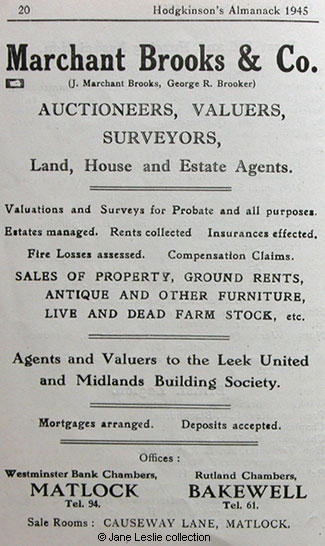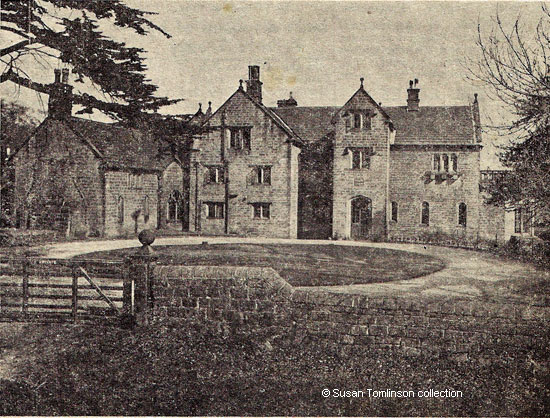|
Images Index> Matlock, 20th and 21stC Images> This page |
| Matlock: Marchant Brooks Sale Rooms, Causeway Lane, 1946 |
| Matlock : Twentieth Century Photographs, Postcards, Engravings & Etchings |
|
|
||||||||||||||
The Nightingale family had first begun to shed some of its Derbyshire property just over a year after the First World War had ended, when a public auction was held at the Crown Hotel by Bagshaws of Ashbourne. On offer then were 470 acres of the outlying portions of their Lea Hurst Estate. The auction lots consisted of three farms, cottages and accommodation lands in the parishes of Dethick, Lea and Holloway as well as Tearsall Farm, in Wensley[1]. The farm tenants were given the option of purchasing their holdings and all but the Wensley and Snitterton farm, which was withdrawn at £2,400, were sold. Lea Hall, a Georgian residence, was bought by George Marple of Sheffield[2], Mr. Lowe bought Lea Farm (57 acres) whilst Messrs J. and F. Smith, tenants of Upper Holloway Farm, bought their holding[3]. The second sale, when the western portion of the Lea Hurst Estate was on the market, took place in June 1925. This part of the estate adjoined the village of Cromford although principally lay in the parish of Matlock. The properties were to be sold by Bagshaws once again, this time in conjunction with Messrs. Tuckett and Webster, and also at the Crown Hotel. The land area available covered 384 acres, 2 roods and 36 perches and the sale included valuable fishing in the River Derwent[4]. The properties advertised on this occasion were Woodseats Farm, Meadow Wood Farm, Bow Wood Farm, Pear Tree Farm, two desirable residences (with early possession) and more accommodation lands and woodland[5]. The lots were auctioned on 7 July 1925. Bridge House at Cromford (formerly Senior Field House) was sold to Mrs. Sorby of Sheffield, Woodend House went to Mr. Raleigh Hills of Higham Cliff and the 70 acre farm Bow Wood was sold to its tenant, Mr. A. Millward. Mr. J. Millward, the tenant of a small holding adjacent to Bow Wood, bought that property and Pear Tree Farm was knocked down to Mr. J. Hallsworth[6]. Meadow Wood Farm and Woodseats Farm were withdrawn from the auction[7], but a few days later it was announced that they would be sold by private treaty[8]. When Lea Hurst was offered for sale in 1946 Marchant Brooks and Co. now had a base in Matlock in addition to one in Bakewell. They were auctioneers, land, house and estate agents, surveyors and valuers, with offices in Westminster Bank Chambers[9]. Their sale rooms, the Central Sale Rooms, were on Causeway Lane. These premises had been used by another auctioneer, W. H. Marriott, until his death. Marchant Brooks had taken them over at the beginning of 1941. The house was bought before the auction date by the estate of Lt.-Col. E. S. Halford as a permanent memorial to Florence Nightingale. His estate had made many gifts to the nursing profession. Marchant Brooks offered the remaining thirty lots on Thursday 23rd May 1946[10]. Despite the earlier substantial sales of its farms and properties Lea Hurst still retained 200 acres of parkland adjoining the house at Holloway.
The final image (below) is of Lea Hurst, photographed by the Marchant Brooks and Co. and published in the Matlock Mercury on 30 June 1951 in readiness for the sale of the property on 3 July. It was taken just before a film crew assembled at the house to shoot the last scenes of "The Lady of the Lamp" starring Anna Neagle.
Robert Spark took over the practice in 1958 and in 1982 it amalgamated with Wheatcrofts. Although the auctioneer's sale room has now gone from Causeway Lane, the building is still there. At one time it was the Thomas Cook building (2013) but is now Mobile Lab. On the side wall, at first floor level, a painted sign is still visible although it is now in unreadable.
|
|||||||||||||||
|
1. Photograph of the 1946 sale in the collection of and provided by and © Ken Smith. 2. 1951 Sale Notice from a copy of the Matlock Mercury © Susan Tomlinson collection. 3. Advertisement for Marchant Brooks from "Hodgkinson's Matlock and Historic Almanack, 1945 (War Edition) " © Jane Leslie collection. 4. Marchant Brooks photo of Lea Hurst also from a copy of the Matlock Mercury © Susan Tomlinson collection. Researched, written by and © Ann Andrews. Intended for personal use only. |
|||||||||||||||
|
[1] "Derbyshire Advertiser and Journal", 7 November 1919. Valuable Freehold Estate, being the outlying portion Of the Lea Hurst Estate. It was to be sold on 19 November 1919. [2] "Nottingham Journal", 19 November 1919.[3] "Derbyshire Courier", 22 November 1919. [4] "Derbyshire Advertiser and Journal", 19 June 1925. Choice Freehold Residential and Sporting Estate. [5] "Derbyshire Times", 13 June 1925. [6] "Sheffield Daily Telegraph", 8 July 1925. Lea Hurst Estate Sale. Benjamin Bryan (1903) had noted that Mrs. Shore Nightingale had sold the planted part of the Bow Wood estate to Mr. A. S. Marsden-Smedley in 1901. She retained the agricultural land. [7] "Derbyshire Times", 11 July 1925. [8] "Derbyshire Advertiser and Journal", 17 July 1925. Meadow Wood contained a little over 95 acres whilst Woodseats was slightly smaller(75a. 1r. 228p.) Both farms were said to have "capital homesteads and buildings". [9] Kelly's Directory, 1925. [10] "Derby Daily Telegraph", 21 May 1946, notice of sale. "Derby Daily Telegraph", 22 May 1946, report of house sale. [11] "Derbyshire Times", 17 February 1950. Cromford Derbyshire. Sale by
auction in four Lots. |











